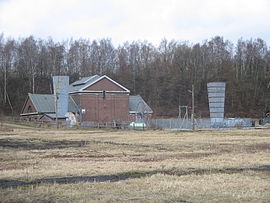Adolf pit
| Adolf pit | |||
|---|---|---|---|
| General information about the mine | |||
| Winding machine house Grube Adolf | |||
| Mining technology | Underground mining | ||
| Funding / year | 939,705 t | ||
| Information about the mining company | |||
| Operating company | Eschweiler Mining Association | ||
| Employees | 2,900 | ||
| Start of operation | 1913 | ||
| End of operation | 1972 | ||
| Funded raw materials | |||
| Degradation of | Hard coal | ||
| Greatest depth | 860 m | ||
| Geographical location | |||
| Coordinates | 50 ° 53 '40 " N , 6 ° 6' 58" E | ||
|
|||
| Location | Merkstein | ||
| local community | Herzogenrath | ||
| City region ( NUTS3 ) | Aachen | ||
| country | State of North Rhine-Westphalia | ||
| Country | Germany | ||
| District | Aachen district | ||
The Adolf mine was a mine in Merkstein , a district of Herzogenrath . She was one of the pits of the Aachen coalfield and promoted from 1913 to 1972 coal .
history
The Merkstein concession for the coal seams in the area of what will later be the Adolf mine was acquired by the Eschweiler Bergwerkverein (EBV) together with the Anna mine in neighboring Alsdorf in the middle of the 19th century . But it wasn't until the end of the century that the EBV decided to build a new mine in the open field between Merkstein and Plitschard. On June 12, 1889, the first groundbreaking ceremony for the pit was made. It was named after Adolf von Steffens , who was chairman of the EBV's supervisory board from 1871 to 1898.
Due to the strong water flow in the rock layers above, the sunk shaft did not reach the first coal until 1908. A year later, a breakthrough was made to the neighboring Anna II mine, which was used for ventilation . The difficult sinking work even forced the EBV to sell neighboring coal fields in 1904 and 1910 .
In 1910 the first steam hoisting machine was installed on Adolf . In 1912 a brick factory was built on the mine site. The EBV also built new settlements in Merkstein for the miners , which allowed the place to grow considerably.
In 1913 it was finally possible to get production going. In 1923 the neighboring weather shaft was finished, and since then Adolf has been an independent pit. In total, Adolf had two shafts, and ventilation was carried out together with neighboring pits. The mine had its own colliery station with a rail connection to Merkstein station and its own rail connection to Alsdorf to the station of the mine and coking plant Anna.
In 1929, Adolf was the first EBV mine to switch the entire underground operation from compressed air to electric drive. In the 1930s, Adolf also received a modern coal washing facility .
During the Second World War , the fighting in the Aachen area repeatedly impaired the power supply to the pits in the Aachen district. As a result, several of Adolf's soles fell off and were badly damaged. After the war damage had been repaired, however, production was quickly restarted. In 1959, it reached its historic high for the year with 939,705 tons of coal. At the beginning of the 1970s, the workforce was around 2,900. With the completely mechanical dismantling since 1963, Adolf achieved a shift performance of 3.4 tons per man in 1971.
In 1972, the connection with the Anna mine was established on the 860 m level. This ended the mining in Merkstein, the two shafts were briefly used for rope travel and then only as a weather shaft. The remaining coal was brought to light until 1982 at Anna and then at the Emil Mayrisch mine , the penultimate mine in the Aachen mining area. The brickworks had already been closed in 1968.
Remaining buildings
The factory facilities of the Adolf pit were demolished after the closure, after the winding towers had initially been retained for a few years due to their function as a weather shaft. The hoisting machine house, in which the steam engine from the year the first mining was started, has been preserved. In addition, two pit fans have also been preserved. The ensemble is looked after by the association "Bergbaudenkmal Adolf eV" . But most striking legacy is the subsequent directly to the mining area mining heap .
swell
- Daniel Salber: The Aachen area. 150 years of coal mining at Wurm and Inde. Verlag Schweers + Wall, Aachen 1987, ISBN 3921679567 .
Individual evidence
- ↑ http://www.guidorademacher.de/Bergbaulokomotiven%20im%20Aachener%20Revier/Grube%20Adolf/Grube%20Adolf.htm accessed on October 6, 2019


